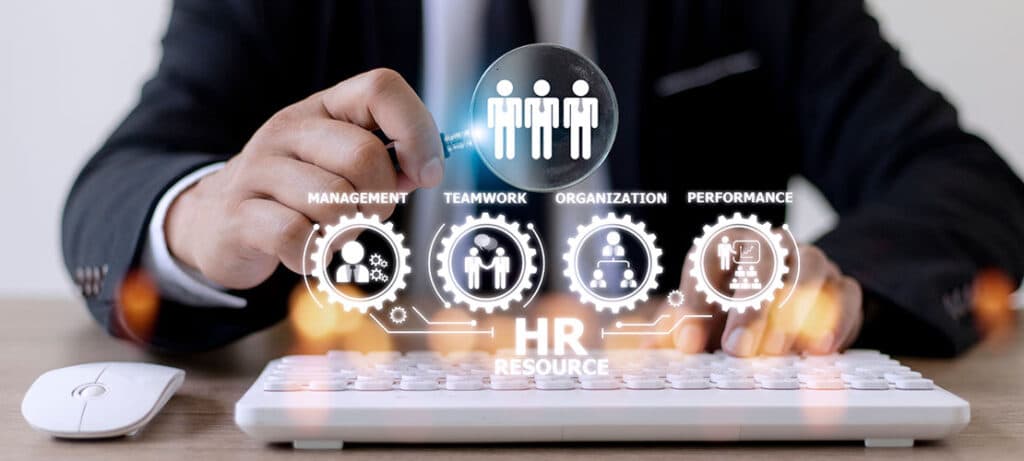Did you know over 32% of employees wait up to three months for performance feedback? Most businesses only conduct performance reviews on an annual or bi-annual basis. While this may have worked, it doesn’t have your company’s best interest in mind.
Performance management is key to your success when building a thriving workplace environment. This ongoing process helps your team members meet strategic objectives and provides access to the tools they need to reach and exceed their goals at your company.
With performance management, your team may grow professionally and personally. They’ll get stuck in the chaos of the 9-5 and will always stay within their comfort zone and go above and beyond during the workweek. While you may hit your revenue numbers every month or quarter, you’ll never grow your business to its full potential.
As a manager or a Human Resources professional, you always want what’s best for your team. You want to guide them toward their business objectives and provide meaningful performance feedback that helps them grow in and outside of the workplace.

With a performance management strategy, you can provide the guidance and feedback your team needs to reach their goals confidently. You and your team members can grow together and reach your own goals at a comfortable pace.
If you’re new to performance management, we’re here to help you learn everything you need to know.
We put together a performance management guide so you can learn the ins and outs of this ongoing process and why it benefits the workplace. With this guide, you can fine-tune your strategic approach and find innovative ways to help your business meet your company’s strategic objectives.
Here’s everything you need to know about building an effective performance management system that delivers results.
What is performance management?
Performance management is an ongoing process. It’s a continuous loop of constructive feedback, transparent communication, and strategic objectives between team members and their managers. With performance management, organizations can ensure their team is on track to meet their goals and have the resources they need to succeed.
This tool is utilized in many different businesses, industries, and departments within a business. Whether you’re looking to get your sales team to perform more efficiently or check in with your marketing team’s annual objectives – performance management is a must-have to ensure all team members stay on track, and there’s a clear, concise way to track their progress.
With performance management, employees may understand what’s expected of them, and you may understand each individual’s performance. What do your team members need to do to get a promotion? Are they on track to meet their professional goals? How far are they from reaching their revenue numbers? With a clear and concise plan, team members will know how they’re performing and what they need to do to get to that next stage in their professional careers and guide them toward the tasks that play a key role in their succession planning.
As a manager, you must keep your performance management strategy straightforward. If your approach to performance management needs to be clarified, it can cause a disconnect in the workplace and lead your team down the wrong path and lead them further from the business results you want to see.
Before building your strategic approach, you’ll need to understand the fundamentals of a performance management system. Once you know the basics, you can fine-tune your strategy to meet the unique needs of your business and your team members.
Understanding the performance management cycle
The traditional performance management cycle has five steps. Each step is essential to the process and ensures every team member meets your expectations and that your management team can provide real-time feedback.
You may go through this cycle multiple times with your employees. Each step in the process is essential to your organization’s success and should be planned out accordingly and customized to meet the needs of your business.
Step 1: Planning
During the planning stage, managers work with their employees to set goals and discuss what they need to do to meet goals and expectations. These goals typically align with your employee’s job description or their personal sales goals.
Depending on which department the team works with, the HR team should take some time to walk through the job description details to ensure you and your employees are on the same page regarding workplace expectations.
This will ensure both parties have a clear understanding of the plan and the goals that align with the planning put in place.
Step 2: Monitoring
Once your team members have a plan, the manager will monitor their performance. You may observe them by planning weekly check-ins or watching their monthly progress bars. There may be times during the monitoring process when you’ll need to help your team realign with their goals if they’re falling behind. This is a normal part of the process, allowing your team to provide constructive, regular employee feedback.
Performance management software is an invaluable tool during the monitoring process. It will ensure you always have a pulse on your team members’ goals and help you visualize their success. These visualizations can also help you restrategize with your team members and provide feedback to help them reach their goals.
Step 3: Developing
As a leader in the workplace, you want your team members to do more than just come to work and check off their to-do lists. You want them to develop professionally, take on challenges, and grow as an individual. During the development stage, you’ll utilize the data you pulled while monitoring to fine-tune your strategy and help your team members grow. You’ll also want to consider scheduling development and training programs for each individual.
Whether you sign them up to take online courses to further their career, attend a professional conference, or take a refresher course on a topic related to their position – these small efforts can be worthwhile to their professional development. With the right resources and opportunities, the individual can achieve sustainable progress and become an invaluable asset to your team.
Rating
Rating your employee’s performance will help you find new opportunities for improvement and growth. You can better understand their progress and find ways to improve the planning process in the future.
When rating your employee’s success, it’s best to separate their individual progress from the team’s progress. For example, if your sales team is not meeting their sales goals, but some team members are still hitting their monthly goals, you should keep the progress of others from impacting their overall rating.
For the best results: You’ll also want your managers and team members to provide feedback and ratings. This will ensure both sides are being held accountable. This means every time your managers go through the performance cycle; they’ll have something they’ll have feedback and a rating they can work off of, too.
Rewarding
Rewarding good performance is crucial to the success of the workplace. Employees want to feel recognized and appreciated for their contributions to the workplace. Recognizing your team members with rewards and incentives ensures you reward outstanding performance and encourage repeat behavior.
Whether it recognizes your team on Slack, gives them a badge, or even a cash bonus. These small incentives for good performance will help you improve your HR performance management and give your team the motivation they need to push toward success.
While the traditional system is a great baseline for providing performance feedback, there are more effective performance management systems. Studies suggest some of the disadvantages of traditional modeling include lack of efficiency, de-motivation, and inflexibility.
For the best results, you’ll want to use this system as a framework and utilize software and other tools to help you adapt to the digital age. With meaningful changes, you can build a workplace dynamic that meets the needs of your company strategy and your employee’s personal goals.
Common performance management pitfalls
Now that you know the five stages of the performance management cycle, it’s time to consider some common problems businesses tend to run into.
While performance management is necessary, many organizations musto stay consistent with their coaching, feedback, and open communication. This can negatively impact the workplace experience and cause your team to underperform.
Here are some of the most common pitfalls that businesses struggle with:
Unrealistic targets
The goals set during the planning phase should always be actionable, tangible, and realistic. Setting unrealistic expectations for your team is setting them up to fail. Instead, always be mindful of what is and isn’t possible for the individual employees. It’s always better for them to exceed their goals by 20-30% than to watch them fail by 20%-30%.
Once they reach or exceed their target for one quarter, you can push it up for the next.
Lack of communication
Communication is key to a thriving workplace dynamic. If your HR team or managers are unreachable during the workweek, it may discourage your team members. The lack of communication can lead to misunderstandings and misconceptions. If your team doesn’t feel like they have a support team, they might fail during the planning stages.
Lack of consistency
Performance management only works if you’re consistent and have a regular cadence for feedback and planning.
Without consistent check-ins or performance reviews, your team’s goals will get swept under the rug, and you’ll get caught up in the chaos of the workweek. Your HR and leadership teams should have regular monthly, quarterly, and year check-ins.
This will ensure you can understand your team member’s work performance at every level. Each check-in should be organized and properly structured to ensure you hit all touchpoints in the process and nothing goes unnoticed.
No need for performance management in leadership
While it’s easy to always focus on your employees, your managers need that same level of care and attention. The HR team should also evaluate the manager’s success and provide performance feedback accordingly. This will ensure everyone is always on the same page and is familiar with the goal-setting process that your business has set up.
This will also help managers and leaders grow professionally and be better leaders for the team members.
No engagement or collaboration
Some organizations believe setting goals is enough to keep their employees engaged through 9-5. However, this is far from true. To see results from performance management, you need to engage employees and keep them focused on their goals.
Whether it’s with recognition, sales coaching, check-ins, gamification, or weekly all-hands meetings, these initiatives are designed to keep your team on track to meet business objectives and will complement your performance review initiatives.
Ways to improve your performance management systems
If you already have a performance management system set in place, it doesn’t hurt to revisit your current structure and look for opportunities. Are your team members meeting their goals more consistently with the management system? Are there still challenges and opportunities? Is your setup improving the communication among team members and inspiring workplace collaboration?
If you already have a performance management system in place and you don’t see results, here’s what you can do:
Take a personalized approach.
Every team member is different. This means they will all require a somewhat personalized approach if you want to see results. You can expect different planning or rewards cycles to be more motivating for the individual.
Utilize KPIs and performance metrics.
Key performance indicators provide invaluable insight into your team’s success. You’ll want to choose at least 2-3 KPIs that you can track monthly, quarterly, and annually. These KPIs will help you measure the ongoing success of your team members and help you catch any problems or challenges before they impact your bottom line.
Stay consistent.
Consistent communication, feedback, and a performance management process are key to seeing success. You must do more than just set up meetings at the beginning of the year. You must always check in with your team and revisit your strategy. This way, you can combat the mid-year slump and keep your team on a path towards success.
Switch up your rewards.
Rewards are a must-have, but if you always have the same incentives for every month or quarter, your team may feel they need more motivation to keep trying for them. To improve employee motivation, you’ll want to switch up the rewards and think of innovative incentives that appeal to your team.
If you don’t know what rewards would motivate your team the most, send a survey to gather their results. This way, you can incorporate incentives that appeal to them the most in your strategy.
Celebrate everyone (not just the top performers!)
If you’re only celebrating your top performers every week or month, it can discourage the rest of your team from trying. For example, if you’re measuring the success of your sales team, you’ll want to recognize the individuals that brought in the most sales, the most improved, and the people with the most upsells.
As a leader, you’ll want to look for innovative ways to keep your team engaged. Think outside the box, and always celebrate the wins, whether big or small.
How to utilize performance management software
Once you start checking in with your team and conducting regular performance management, you’ll need a way to track your progress and success. You can’t just meet with your team every week or month and hope for the best or keep track in an Excel sheet.
With the help of performance management software, you can help your team visualize their success and provide them with the tools they need to actively reach their goals and grow as a working professional.
Here’s how performance management software can help:
Streamline productivity
Once you meet with a team member, you’ll want to come to the table with a strategic and integrated approach. You’ll need clear, actionable goals, ideas, and plans for moving forward. With software, you can track all these data in real-time and keep your team working efficiently.
You’ll have a way to stay on top of the feedback, comments, and concerns you had at the previous meeting. With software, you may retain valuable insights you and your team discussed. This can negatively impact productivity and how your team back from their goals.
Provide your team resources.
Performance management is all about feedback, transparent communication, and providing resources to help your team succeed. With the right software, you can provide your team with the resources they need to plan their workweek and take on new challenges.
Manage employee performance and progress.
The software helps managers track their team’s performance in real-time. With these tools, you can visualize your team’s progress, see how close they are to reaching their sales goals, and provide feedback based on these visualizations. Without software, there’s no way of telling where your team is for that month or quarter. This can make it challenging to stay consistent with your goals or to provide feedback that helps with performance improvement.
Set strategic objectives
Every team member needs a set of goals and strategic objectives that will help them get there. The software will help you track your objectives and progress in real-time, giving your team members the tools they need to reach their objectives and visualize their success.
Inspire friendly competition
Friendly competition keeps your team engaged with the 9-5 workplace. When your team can see their coworker’s success, it will push them to do more throughout the workweek. Performance management software gives your team members that extra boost of motivation to help them stay on track with their goals and performance.
Keep your team engaged in the workweek.
Studies suggest that 43% of engaged employees receive feedback once a week. Whether you have a hybrid or a remote team – engagement is essential to the workplace dynamic and your company culture. The software you choose should aim to engage and entertain your team. It should inspire your team to take on the day and confidently tackle challenges.
What to look for in performance management software
Performance management software is essential to the success of your performance management strategy. Your HR and leadership can’t manually track your team’s success – it’s not feasible. You’ll need performance management software to ensure they have time to focus on their day-to-day tasks while keeping your team engaged.
When looking for software to use in the workplace, there are a few things you should look for.
Project management systems
Project management ensures your team members can juggle many different projects at once. This also allows managers to see the progress of each task in real-time. This will improve overall performance and help with succession planning.
Gamification
Gamification is the process of adding game elements to non-gaming contexts. Businesses can use this to motivate employees, inspire friendly competition, and keep the workplace experience entertaining. Gamification aims to keep your team engaged during the work week. It turns mundane workweek tasks into a fun, entertaining experience for everyone.
When looking for performance management software, look for features such as progress bars, leaderboards, and badges.
Data visualization
To help your team stick to their plan for success, you’ll need a way for them to visualize their success. For example, if your sales team never knows how close they reach their goals, how can you expect them to achieve them? With leaderboards and progress bars, employees can track progress in real-time. This will help them plan out their workweek efficiently.
Data visualization also helps managers track individual performance. They can then use this data to structure their weekly check-ins.
Coaching tools
Coaching employees pushes each individual to work towards their goals. Coaching tools help you tailor your coaching style for each team member and visualize their progress with performance analytics. Managers can also prepare talking points in advance and keep a log of ideas to come back to.
Recognition and reward system
A built-in reward system will provide instant gratification for their positive performance, whether they receive a badge for reaching their goal or receive recognition from their manager or other team members. This is essential to ensure your team stays on track with organizational goals. Studies suggest companies with recognition programs have 31% lower voluntary turnover.
Seamless communication
The platform you choose should keep your team engaged and connected, whether it’s to celebrate the wins of the week, milestones, or goals. With seamless communication tools, you can keep your team engaged and provide continuous performance feedback.
Connectivity
The software should be accessible from computers, TVs, and mobile devices. This ensures your team can stay informed about their performance and keep their team members informed.
Reminders and notifications
Reminders and notifications keep your team’s performance and goals top of mind. These notifications are like daily check-ins and reminders of their success. With reminders, they may stay caught up on their goals.
HRM performance management best practices
Have a strategy
Strategies provide structure. They help your managers and team members successfully conduct a performance evaluation with the business objectives in mind. While each team member may require a different personalized approach, it’s good to have an overarching strategy you can keep in mind while building a plan for each team member.
Prioritize transparent communication
With clear, concise, and transparent communication – your team will get where they need to be. Your managers should always make communication a priority when managing performance. Managers should provide timely responses to all team members and provide actionable insights and feedback each team member can benefit from.
Consider implementing regular training sessions if your team members need help with open communication.
Monitor performance
The monitoring part of the cycle is one of the most essential parts of the process. You may be setting goals for your team and creating a game plan, but how will you ever know if it’s enough? How will you know if the strategies you used worked?
Managers should take some time to monitor performance and review the data before meeting with individual employees. This will ensure they have a data-driven understanding and know what feedback they need to improve.
Capitalize on performance management software.
Performance management software is a must-have. You can’t expect to manually track your team’s success, performance targets, or career development. With the help of technology and tools, you can deliver continuous feedback and coach employees through challenges.
Performance management software also helps you automate the performance process and ensure that performance management is always top of mind for your team. This means every workday will be structured with your team members in mind.
Training programs
Training and development programs are tools that can help you fine-tune your team’s skills and job satisfaction. Whether training sessions to teach them new skills required for the position or when they start working for your company. Businesses with training programs set in place see 41% lower absenteeism rates and 17% higher productivity.
If you need help determining which skills your team members want to hone in on, ask them! During coaching sessions and performance management meetings, you can better understand your team members by asking them what skills they want to improve or what training needs to be done.
How Spinify Can Help With Your Performance Management System
Spinify is an invaluable performance management tool designed to enhance the workplace experience for team members, managers, and leaders in the business. With our software, you can get more from your workweek. You can utilize the power of gamification to boost your team’s performance and tailor the experience to help them reach their individual goals.
We’ve carefully crafted a performance management solution that will help you level up your results and help your team reach their targets while celebrating every achievement along the way.
With gamification, we turn everyday scenarios into entertaining experiences for everyone. So you can inspire friendly competition while impacting your bottom line. Companies that utilize our solution saw a 208% increase in KPI tracking and visibility. 92% noticed their targets were hit more frequently, and 43% saw an increase in sales.
The best part? Our performance management integrates seamlessly with your existing platforms, so you never need to skip a beat.
The Spinify Benefits for Team Performance
With our platform, you can achieve continuous performance management and always have a pulse on your team’s success. You can conduct a performance appraisal, improve employee engagement, and turn the performance into a continuous process.
If you are new, Spinify is a platform that can help with human resource management and monitoring performance for each department.
If you notice any inconsistencies with data or poor performance, you can set strategic goals and rethink your business strategy to help your team get back on track.
Here’s how we can help with employee development:
Spinify AI-Enhanced Gamification
We created a tool called Spinify Sidekick. This allows us to enhance our gamification approach and utilize Spinify AI’s power to improve workplace productivity and inspire your team. With the addition of AI, your team will have access to creative ideas at their fingertips.
Anytime they’re in a creative rut or need some daily inspiration, they can count on our Spinify Sidekick for a mid-day creative pick-me-up. This will improve performance and help your team stay on task throughout the work week.
Competitions & Visibility
Nothing wrong with a little friendly competition! Competition helps motivate your team to go above and beyond with their sales goals. It pushes them to think outside of the box so they can show up at the top of the leaderboards every week.
With our gamification tools, you can turn every workday into an interactive experience for your team; it will hardly even feel like work!
This will help your team fight off that mid-day slump or unwanted feelings of burnout, keeping them on task throughout the entire year and motivated to improve their performance.
Recognition & Fun
Team members want to feel recognized. They want to feel like their contributions to the workplace don’t go unnoticed. With Spinify, you can improve morale and celebrate every big or small achievement.
For example, every time a team member reaches their goals, their favorite song will play to celebrate. We also use emojis, gifs, points, and badges to celebrate each of your team members. Every time they clock in for work, they’ll feel motivated and inspired to take their performance to the next level.
We also automated all of our reward systems. Anytime your team member reaches their goals, they’ll instantly receive a badge- so you can feel confident that performance is always top of mind for your team members, and you don’t always have to keep track of their progress.
Coaching
Our platform also provides insight to help you train and coach your employees during the planning stage of the performance management cycle. This way, you can make data-driven changes to the workplace dynamic and help your team members improve professionally.
With our performance grid and scorecards, you can see real-time stats on each team member’s performance. Managers will also have the tools required to prepare for meetings in advance and help team members overcome obstacles and stay on track.
Metrics & Targets
Our metrics help managers and team members create and track their daily goals. Whether you want to go back and reference historical data, realign your team’s targets for different months, or create weekly deadlines for smaller tasks – our platform can help.
Common goals that can be set up in our system include new trials, webinar attendees, NPS years to date, upsells and cross-sells, 500 calls in a week, and solved tickets for the week.
Improve employee performance with Spinify.
A performance management system is a must-have in today’s digital age. If you are staying on track with your team’s performance, it can positively impact the workplace experience. At Spinify, our performance management software is an invaluable tool that can help you enhance the workplace experience for you and your team members.
With our software, you can help your team visualize their success and provide them with meaningful feedback based on performance data.
Our performance management software integrates with a variety of different systems. Our tools are also customizable to meet the needs of your team.
Book a demo with us today if you’re ready to get more from your performance management initiatives.



